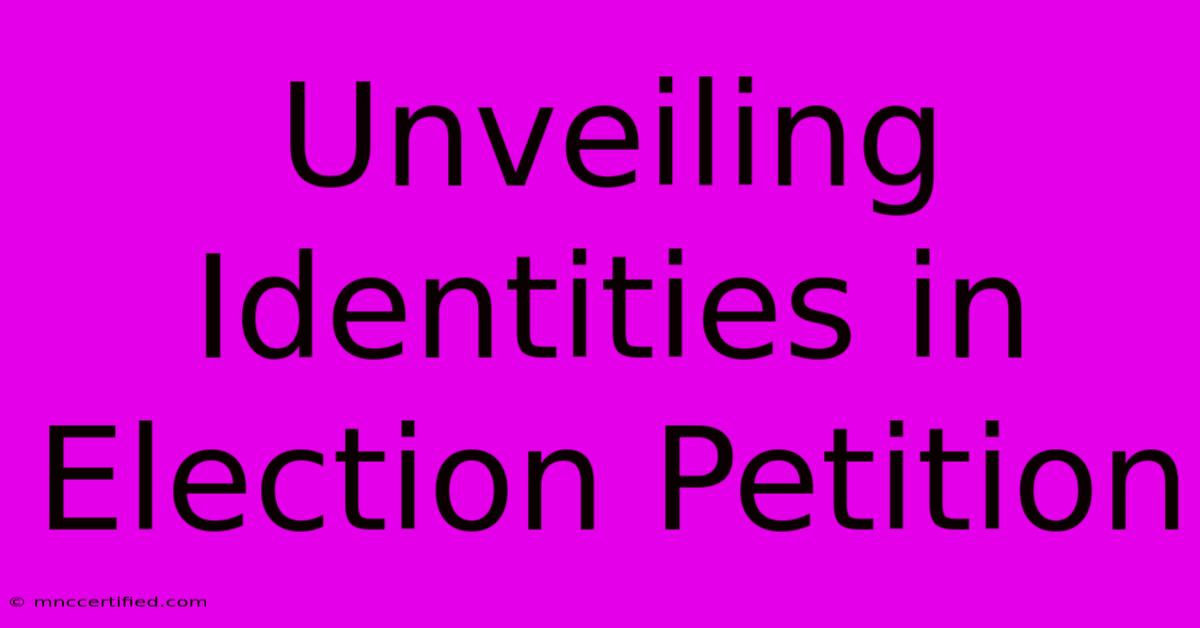Unveiling Identities In Election Petition

Table of Contents
Unveiling Identities in Election Petitions: A Legal and Strategic Guide
Election petitions often hinge on uncovering the truth behind alleged electoral irregularities. A crucial aspect of this process involves unveiling identities – whether it's identifying fraudulent voters, uncovering the source of misinformation, or exposing individuals involved in vote rigging. This process requires careful legal navigation and strategic planning. This article delves into the complexities of identifying key players in election disputes, examining the legal frameworks, practical challenges, and strategic considerations involved.
The Legal Framework for Unveiling Identities
The legal basis for compelling the disclosure of identities varies depending on the jurisdiction. Many countries have laws governing election petitions that explicitly grant the petitioner the power to request information and compel witnesses to testify, including revealing their identities if relevant to the case. These laws often incorporate provisions for protecting the confidentiality of individuals where necessary, especially if revealing their identity puts them at risk.
Subpoenas and Court Orders:
One of the primary legal tools used to unveil identities is the subpoena. Petitioners can use subpoenas to compel individuals, organizations, or entities holding relevant information to appear before the court and produce evidence, including revealing identities concealed behind pseudonyms or anonymous accounts. Court orders, issued based on compelling evidence, can also force disclosure of identities involved in fraudulent activities.
Data Protection and Privacy Concerns:
However, the pursuit of identifying individuals must always be balanced against data protection and privacy rights. Courts generally require petitioners to demonstrate a compelling reason for revealing an individual's identity, ensuring that the need for disclosure outweighs the potential harm to the individual's privacy. The process should be conducted transparently and within the confines of the law, adhering to strict rules of evidence.
Strategic Considerations for Identifying Key Players
Successfully unveiling identities in election petitions demands a strategic approach. This involves:
Identifying Potential Witnesses:
Before initiating legal action, petitioners must meticulously identify potential witnesses who possess crucial information. This may involve analyzing election records, social media activity, witness testimonies, and other sources of evidence to pinpoint individuals who can corroborate allegations of irregularities.
Gathering Evidence:
Collecting compelling evidence is crucial to support requests for disclosure of identities. This evidence must be legally admissible and relevant to the petition. Examples include:
- Digital Forensics: Investigating electronic records, social media posts, and online communications to identify individuals involved in spreading misinformation or orchestrating fraudulent activities.
- Witness Testimonies: Securing sworn statements from credible witnesses who can identify individuals involved in electoral irregularities.
- Financial Records: Examining financial transactions to trace the flow of funds used in illicit election activities.
Protecting Witness Identities:
While uncovering identities is essential, protecting the safety and anonymity of witnesses who may fear retribution is paramount. Petitioners must implement measures to protect witness identities, such as witness protection programs or using pseudonyms during testimony while still ensuring the integrity of the evidence presented.
Challenges in Unveiling Identities
The process of unveiling identities in election petitions is fraught with challenges:
- Resistance from Individuals and Organizations: Individuals and organizations implicated in electoral irregularities may actively resist attempts to disclose their identities.
- Legal Hurdles: Navigating complex legal frameworks surrounding data protection and privacy can be time-consuming and challenging.
- Resource Constraints: Investigating and pursuing legal action to unveil identities can be resource-intensive, requiring financial resources and legal expertise.
Conclusion: A Necessary but Delicate Process
Unveiling identities in election petitions is a crucial aspect of ensuring fair and transparent elections. However, this process demands careful legal navigation, strategic planning, and a commitment to balancing the need for transparency with the protection of individual rights. By understanding the legal framework, employing effective investigative strategies, and addressing potential challenges proactively, petitioners can significantly increase their chances of successfully uncovering the truth and upholding the integrity of the electoral process. The success hinges on a diligent approach that prioritizes both legal compliance and strategic efficacy.

Thank you for visiting our website wich cover about Unveiling Identities In Election Petition. We hope the information provided has been useful to you. Feel free to contact us if you have any questions or need further assistance. See you next time and dont miss to bookmark.
Featured Posts
-
Cross Insurance Lewiston Maine
Nov 27, 2024
-
Aberdeen Fc Scraps Fan Zone Alcohol
Nov 27, 2024
-
Farm Bureau Insurance Bay City
Nov 27, 2024
-
3 0 Victory For Sheffield United
Nov 27, 2024
-
Will Insurance Pay For Veneers
Nov 27, 2024